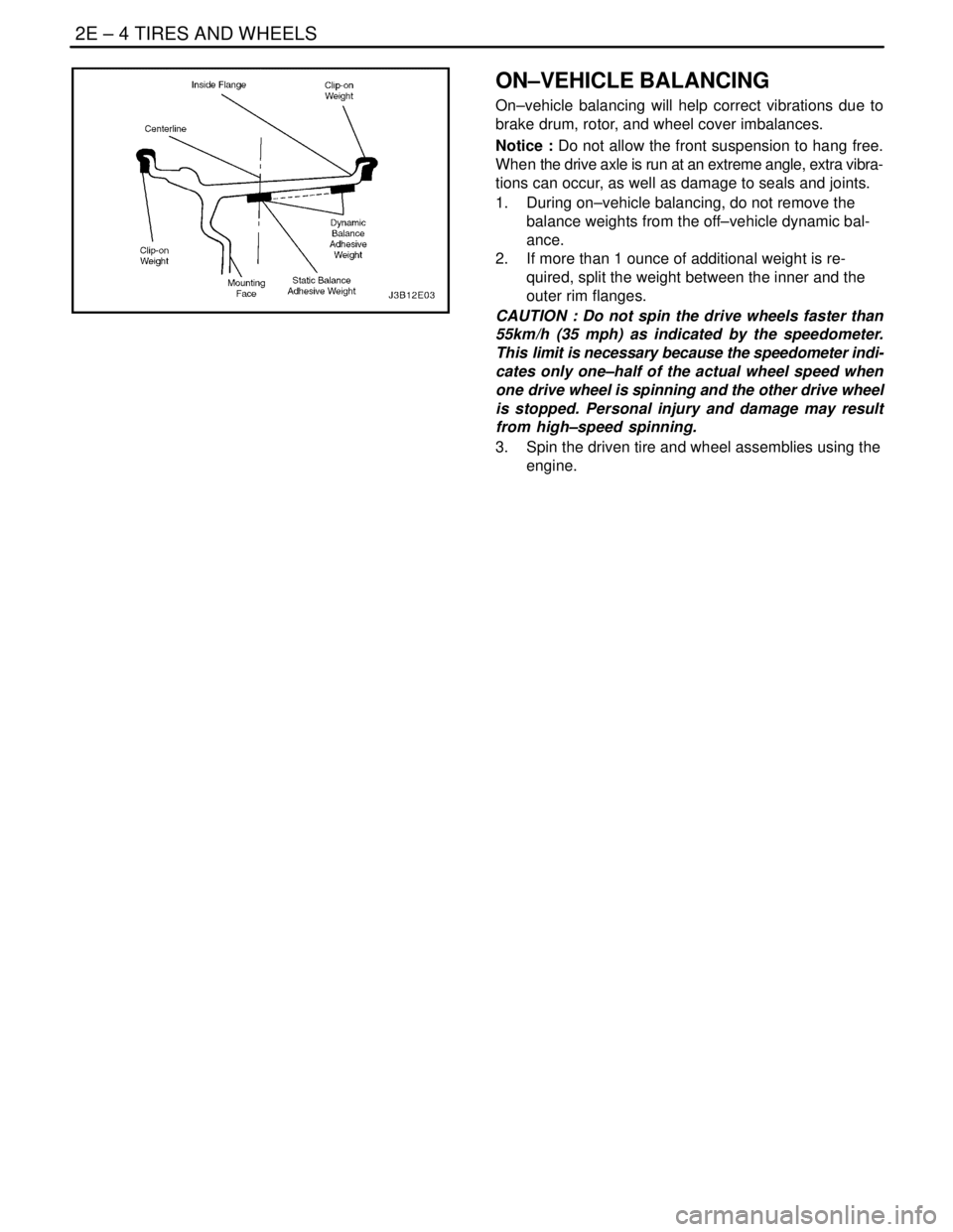2004 DAEWOO LACETTI weight
[x] Cancel search: weightPage 751 of 2643

ENGINE CONTROLS 1F – 505
DAEWOO V–121 BL4
S Fuel system too rich or too lean.
S Foreign material in the throttle body bore or in the
air induction system.
S A leaking or restricted intake manifold.
S Excessive engine overloading. Check for seized
pulleys, pumps, or motors on the accessory drive.
S Overweight engine oil.
Test Description
Number(s) below refer to the step number(s) on the Diag-
nostic Table.
1. The On–Board Diagnostic (EOBD) System Check
prompts the technician to complete some basic
checks and store the freeze frame and failure re-
cords data on the scan tool if applicable. This
creates an electronic copy of the data taken when
the malfunction occurred. The information is then
stored on the scan tool for later reference.
2. A normally operating IAC system will be able to be
extended and retracted by a scan tool and change
the engine idle rpm. Valve movement is verified by
an engine rpm change.
3. If the scan tool was able to command the IAC valve
smoothly, a malfunction may still exist internally
within the IAC valve. This can be checked by
checking the IAC valves internal resistance.5. The IAC circuits always have ground or voltage sig-
nals on them in pairs. If the test light illuminates on
more or less than 2 terminals, 1 of the circuits is
shorted to voltage or open.
6. The IAC circuits always have ground or voltage sig-
nals on them in pairs. If the test light illuminates on
more or less than 2 terminals, 1 of the circuits is
shorted to ground or open
8. The IAC circuits are constantly switched between
ground and voltage so the test light should blink on
all circuits when connected to ground.
10. Any circuitry, that is suspected as causing the inter-
mittent complaint, should be thoroughly checked for
backed–out terminals, improper mating, broken
locks, improperly formed or damaged terminals,
poor terminal– to–wiring connections or physical
damage to the wiring harness.
12. A test light that remains ON constantly indicates
that the circuit is shorted to voltage.
14. The replacement ECM must be reprogrammed.
Refer to the latest Techline procedure for ECM re-
programming.
16. If no malfunctions have been found at this point and
no additional DTCs were set, refer to ”Diagnostic
Aids” in this section for additional checks and infor-
mation for additional checks and information.
DTC P0507 – Idle Speed RPM Higher Than Desired Idle Speed
StepActionValue(s)YesNo
1Perform an On–Board Diagnostic (EOBD) System
Check.
Was the check performed? –Go to Step 2Go to
”On–Board
Diagnostic Sys-
tem Check”
21. Install a scan tool to the Data Link Connector
(DLC).
2. Operate the engine to idle speed.
3. Transmission in park or neutral and the parking
brake set.
4. A/C is Off.
5. Using scan tool, command the Idle Air Control
(IAC) valve up and down between the specified
value.
Does the rpm change smoothly when he command-
ed by the scan tool?900–1200 rpmGo to Step 3Go to Step 5
31. Turn the ignition OFF.
2. Disconnect the IAC valve connector.
3. Measure the resistance between terminal D
and C of the IAC valve.
4. Measure the resistance between terminal B
and A of the IAC valve.
Is the resistance within the specified value?40–80 WGo to Step 4Go to Step 13
41. Measure the resistance between terminal C
and B of the IAC valve.
2. Measure the resistance between terminal D
and A of the IAC valve.
Is the resistance equal to the specified value?–Go to Step 15Go to Step 13
Page 880 of 2643

1F – 634IENGINE CONTROLS
DAEWOO V–121 BL4
A rough road sensor, or G sensor, works together with the
misfire detection system. The G sensor produces a volt-
age that varies along with the intensity of road vibrations.
When the ECM detects a rough road, the misfire detection
system is temporarily disabled.
Misfire Counters
Whenever a cylinder misfires, the misfire diagnostic
counts the misfire and notes the crankshaft position at the
time the misfire occurred. These ”misfire counters” are ba-
sically a file on each engine cylinder. A current and a histo-
ry misfire counter are maintained for each cylinder. The
misfire current counters (Misfire Cur #1–4) indicate the
number of firing events out of the last 200 cylinder firing
events which were misfires. The misfire current counter
will display real time data without a misfire Diagnostic
Trouble Code (DTC) stored. The misfire history counters
(Misfire Hist #1–4) indicate the total number of cylinder fir-
ing events which were misfires. The misfire history count-
ers will display 0 until the misfire iagnostic has failed and
a DTC P0300 is set. Once the misfire DTC P0300 is set,
the misfire history counters will be updated every 200 cyl-
inder firing events. A misfire counter is maintained for each
cylinder.
If the misfire diagnostic reports a failure, the diagnostic
executive reviews all of the misfire counters before report-
ing a DTC. This way, the diagnostic executive reports the
most current information.
When crankshaft rotation is erratic, a misfire condition will
be detected. Because of this erratic condition, the data
that is collected by the diagnostic can sometimes incor-
rectly identify which cylinder is misfiring.
Use diagnostic equipment to monitor misfire counter data
on On–Board Diagnostic (EOBD) compliant vehicles.
Knowing which specific cylinder(s) misfired can lead to the
root cause, even when dealing with amultiple cylinder mis-
fire. Using the information in the misfire counters, identify
which cylinders are misfiring. If the counters indicate cylin-
ders numbers 1 and 4 misfired, look for a circuit or compo-
nent common to both cylinders number 1 and 4.
The misfire diagnostic may indicate a fault due to a tempo-
rary fault not necessarily caused by a vehicle emission
system malfunction. Examples include the following
items:
S Contaminated fuel.S Low fuel.
S Fuel–fouled spark plugs.
S Basic engine fault.
Fuel Trim System Monitor Diagnostic
Operation
This system monitors the averages of short–term and
long–term fuel trim values. If these fuel trim values stay at
their limits for a calibrated period of time, a malfunction is
indicated. The fuel trim diagnostic compares the averages
of short–term fuel trim values and long–term fuel trim val-
ues to rich and lean thresholds. If either value is within the
thresholds, a pass is recorded. If both values are outside
their thresholds, a rich or lean DTC will be recorded.
The fuel trim system diagnostic also conducts an intrusive
test. This test determines if a rich condition is being
caused by excessive fuel vapor from the Evaporative
(EVAP) Emission canister. In order to meet EOBD require-
ments, the control module uses weighted fuel trim cells to
determine the need to set a fuel trim DTC. A fuel trim DTC
can only be set if fuel trim counts in the weighted fuel trim
cells exceed specifications. This means that the vehicle
could have a fuel trim problem which is causing a problem
under certain conditions (i.e., engine idle high due to a
small vacuum leak or rough idle due to a large vacuum
leak) while it operates fine at other times. No fuel trim DTC
would set (although an engine idle speed DTC or HO2S2
DTC may set). Use a scan tool to observe fuel trim counts
while the problem is occurring.
A fuel trim DTC may be triggered by a number of vehicle
faults. Make use of all information available (other DTCs
stored, rich or lean condition, etc.) when diagnosing a fuel
trim fault.
Fuel Trim Cell Diagnostic Weights
No fuel trim DTC will set regardless of the fuel trim counts
in cell 0 unless the fuel trim counts in the weighted cells are
also outside specifications. This means that the vehicle
could have a fuel trim problem which is causing a problem
under certain conditions (i.e. engine idle high due to a
small vacuum leak or rough due to a large vacuum leak)
while it operates fine at other times. No fuel trim DTC
would set (although an engine idle speed DTC or HO2S2
DTC may set). Use a scan tool to observe fuel trim counts
while the problem is occurring.
Page 903 of 2643

2A – 2ISUSPENSION DIAGNOSIS
DAEWOO V–121 BL4
Abnormal or Excessive Tire Wear
ChecksAction
Check the front–wheel and the rear–wheel alignment.Align the front and the rear wheels.
Inspect for excessive toe on the front and the rear wheels.Adjust the toe on the front and the rear wheels.
Inspect for a broken or a sagging spring.Replace the spring.
Inspect for out–of–balance tires.Balance the tires.
Inspect for worn strut dampeners.Replace the strut dampeners.
Check for a failure to rotate tires.Rotate the tires. Replace the tires as needed.
Check for an overloaded vehicle.Maintain the proper load weight.
Inspect for low tire inflation.Inflate the tires to the proper pressure.
Scuffed Tires
ChecksAction
Inspect for incorrect toe on the front and the rear wheels.Adjust the toe on the front and the rear wheels.
Inspect for a twisted or a bent suspension arm.Replace the suspension arm.
Wheel Tramp
ChecksAction
Inspect for an out–of–balance tire or wheel.Balance the tire or the wheel.
Inspect for improper strut dampener action.Replace the strut dampeners.
Shimmy, Shake, or Vibration
ChecksAction
Inspect for an out–of–balance tire or wheel.Balance the tire or the wheel.
Inspect for excessive wheel hub runout.Measure the hub flange runout. Replace the hub as need-
ed.
Inspect for excessive brake drum or brake rotor imbal-
ance.Adjust the brakes. Replace the brake rotor or the brake
drum as needed.
Inspect for worn tie rod ends.Replace the outer tie rods.
Inspect for wheel trim imbalance.Balance the wheel.
Inspect for a worn lower ball joint.Replace the lower ball joint.
Inspect for excessive wheel runout.Measure the wheel runout. Replace the wheel as needed.
Inspect for excessive loaded radial runout on the tire and
wheel assembly.Match–mount the tire and wheel assembly.
Hard Steering
ChecksAction
Check the steering gear preload adjustment.Perform a rack bearing preload adjustment.
Check the hydraulic system. Test the power steering sys-
tem pressure with a gauge.Replace the seals and the hoses as needed.
Inspect for binding or catching in the steering gear.Lubricate the steering gear. Repair or replace the steering
gear as needed.
Inspect for a loose steering gear mounting.Tighten the steering gear mounting bracket nuts.
Page 905 of 2643

2A – 4ISUSPENSION DIAGNOSIS
DAEWOO V–121 BL4
Checks Action
Check the steering gear preload adjustment.Perform a rack bearing preload adjustment.
Check the front–wheel and the rear–wheel alignment.Align the front and the rear wheels.
Erratic Steering when Braking
ChecksAction
Inspect for worn or loose wheel bearings.Replace the wheel bearings.
Inspect for a broken or a sagging spring.Replace the spring.
Inspect for a leaking wheel cylinder or caliper.Replace the wheel cylinder or the caliper.
Inspect for warped rotors.Replace the rotors.
Inspect for an incorrect or an uneven caster.If the caster is beyond specifications, check the frame and
repair it as needed.
Low or Uneven Trim Height
ChecksAction
Inspect for a broken or a sagging spring.Replace the spring.
Check for an overloaded vehicle.Maintain the proper load weight.
Inspect for an incorrect or weak spring.Replace the spring.
Ride Too Soft
ChecksAction
Inspect for worn strut dampeners.Replace the strut dampeners.
Inspect for a broken or a sagging spring.Replace the spring.
Ride Too Harsh
ChecksAction
Inspect for incorrect strut dampeners.Replace the strut dampeners.
Inspect for an incorrect spring.Replace the spring.
Body Leans or Sways in Corners
ChecksAction
Inspect for a loose stabilizer shaft link.Tighten the stabilizer shaft link.
Inspect for worn strut dampeners or strut mountings.Replace the strut dampeners. Tighten the strut assembly
mounting bolts.
Check for an overloaded vehicle.Maintain the proper load weight.
Inspect for a broken or a sagging spring.Replace the spring.
Suspension Bottoms
ChecksAction
Inspect for worn strut dampeners.Replace the strut dampeners.
Check for an overloaded vehicle.Maintain the proper load weight.
Inspect for a broken or a sagging spring.Replace the spring.
Page 962 of 2643

2D – 20IREAR SUSPENSION
DAEWOO V–121 BL4
GENERAL DESCRIPTION
AND SYSTEM OPERATION
REAR SUSPENSION
The rear suspension is fully independent and consists of
a crossmember with four parallel links, two trailing links,
two strut assemblies with coil springs and insulators, and
two knuckles containing the hub and bearing assemblies.
The strut assemblies support the weight of the vehicle us-
ing coil springs positioned around the strut dampeners.The coil springs are seated on insulators attached to the
upper mount and the lower spring seat of the strut assem-
bly. The parallel links and the trailing link bracket have rub-
ber isolator bushings at each end and are attached to the
crossmember and the knuckle. The rear parallel link is at-
tached to the crossmember through adjustment cams that
are used to adjust rear toe. The trailing links are attached
to the body, through the trailing link bracket, and the bot-
tom of the knuckle. A forged knuckle bolts to each strut as-
sembly. Lateral movement of the knuckle is controlled by
the parallel links. Fore and aft movement of the knuckle is
controlled by the trailing link.
Page 965 of 2643

TIRES AND WHEELS 2E – 3
DAEWOO V–121 BL4
MAINTENANCE AND REPAIR
ON–VEHICLE SERVICE
WHEEL
Removal Procedure
1. Loosen the wheel bolts.
2. Raise and suitably support the vehicle.
3. Remove the wheel bolts.
Notice : Never use heat to loosen a tight wheel. It can
shorten the life of the wheel, the wheel nuts and the wheel
bearings. Excessive force, such as hammering the wheel
or tire, can also cause damage and is not recommended.
Slight tapping of the wheel sidewall with one’s hand or with
a rubber mallet is acceptable.
4. Remove the wheel.
Difficulty in removing the wheels from the vehicle can be
due to foreign material or to a tight fit between the wheel
centerhole and the hub or the rotor. These wheels can be
removed by
5. Retightening the wheel bolts on the affected wheel
and then loosening the wheel bolts by two turns.
6. Lowering the vehicle and rocking it from side to side
as hard as possible, using one or more person’s
body weight to loosen the wheel.
7. Raising the vehicle and removing the wheel.
CAUTION : Do not allow the penetrating oil to get on
the vertical surfaces between the wheel and the drum
(or rotor) because penetrating oil in this area could
cause the wheel to work loose as the vehicle is driven,
resulting in loss of control and an injury accident.
Penetrating oil is not effective in removing tight wheels. If
it is used, however, apply it sparingly and only to the
wheel’s centerhole area.
Installation Procedure
Notice : Before installing the wheels, remove any buildup
of corrosion on the wheel mounting surface and the brake
drum or the rotor mounting surface by scraping and brush-
ing them with a wire brush. Installing the wheels without
good metal–to–metal contact at the mounting surfaces
can cause the wheel nuts to loosen, which can later allow
a wheel to come off while the vehicle is moving. Wheel
bolts must be tightened in sequence and to the proper
torque to avoid bending the wheel, the brake drum or the
rotor.
1. Mount the wheel.
2. Install the wheel bolts in the sequence shown. Do
not tighten the wheel bolts.
3. Lower the vehicle.
Tighten
Tighten the wheel bolts to 100 NSm (74 lb–ft).
Page 966 of 2643

2E – 4ITIRES AND WHEELS
DAEWOO V–121 BL4
ON–VEHICLE BALANCING
On–vehicle balancing will help correct vibrations due to
brake drum, rotor, and wheel cover imbalances.
Notice : Do not allow the front suspension to hang free.
When the drive axle is run at an extreme angle, extra vibra-
tions can occur, as well as damage to seals and joints.
1. During on–vehicle balancing, do not remove the
balance weights from the off–vehicle dynamic bal-
ance.
2. If more than 1 ounce of additional weight is re-
quired, split the weight between the inner and the
outer rim flanges.
CAUTION : Do not spin the drive wheels faster than
55km/h (35 mph) as indicated by the speedometer.
This limit is necessary because the speedometer indi-
cates only one–half of the actual wheel speed when
one drive wheel is spinning and the other drive wheel
is stopped. Personal injury and damage may result
from high–speed spinning.
3. Spin the driven tire and wheel assemblies using the
engine.
Page 968 of 2643

2E – 6ITIRES AND WHEELS
DAEWOO V–121 BL4
S Amchem Alodine No. 1001. Stock No. DX50T or
equivalent coating chemical for alloys.
S Ditzler Delclear Acrylic Urethane Clear, Stock No.
DAU–75 or equivalent.
S Ditzler Delthane Ultra–Urethane Additive, Stock No.
DXR–80 or equivalent.
Before repairing the alloy damage or the clear coat dam-
age, prepare the wheels and the tires.
1. Remove the wheel from the vehicle.
2. Mark the location of the outboard weights and re-
move them.
3. Wash the wheel inside and out with a water–based,
all–purpose cleaner. Remove the grease and oil
with a solvent cleaner.
4. Mask the tire prior to painting.
5. Using a 400–grit wet or dry sandpaper, sand over
the painted areas that will not require recoloring.
Sanding will promote the adhesion of the clear coat.
Alloy Damage on Wheel Surface
1. Mount the wheel on a brake lathe and spin the as-
sembly slowly.
2. Sand the wheel with a backing block or pad. Hold
the backing block or pad flat to the surface of the
wheel and sand slowly back and forth from the cen-
ter to the outer edge of the tire to remove the dam-
age. Use the following sandpaper grits in the order
listed:
1) 80 grit.
2) 150 grit.
3) 240 grit.
Clear Coat Damage on Unpainted Wheels
1. Apply the chemical stripper Amchem Alumi Prep
No. 33. Use a small 1/4–inch detail brush to apply
the stripper around the perimeter and spoke–like
areas.
2. Remove the stripper according to the manufactur-
er’s recommendations.
CAUTION : To avoid serious personal injury, do not
use engine power to rotate the wheel while sanding.
3. Sand the wheel with 240–grit sandpaper by rotating
the wheel on a slow–spinning brake lathe or by
mounting the wheel on the car and spinning it by
hand. Sanding restores the machined appearance
and promotes adhesion.
After repairing the alloy or clear coat damage, the wheels
must be recoated.